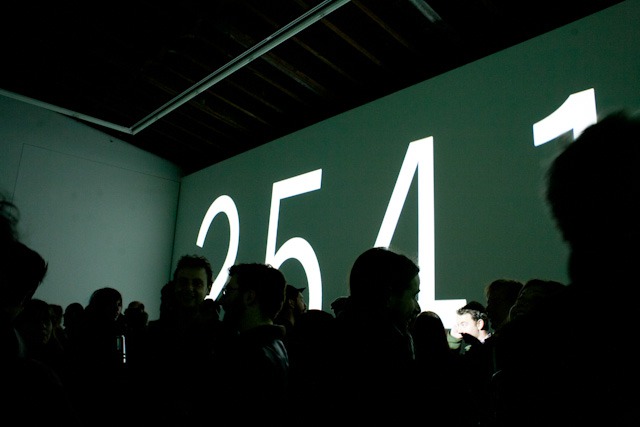By Deborah Brown
[singlepic id=763 w=640 h=427 float=center]
Photos by Katarina Hybenova
Last Friday night in Bushwick the normally desolate strip of Knickerbocker Avenue at Johnson was transformed by the inaugural opening of Luhring Augustine Bushwick. The well-regarded Chelsea gallery opened its long-awaited Bushwick annex with a major show by pioneering video artist Charles Atlas. Throughout the three hour opening–normal for Bushwick but long by Chelsea standards–a small crowd milled around outside the well-lighted, elegantly transformed former warehouse space. Well-heeled guests arrived in Dial cars while local artists gave directions to first-time visitors clearly flummoxed by the unfamiliar geography of the neighborhood.
Inside was a scene of contrasts. Many local artists were in attendance including William Powhida, Stephen Truax, Will Pappenheimer, Carol Salmanson, Letha Wilson, and Max Warsh of the gallery collective Regina Rex. But unlike openings at galleries run by local artists, many attendees were not Bushwick regulars. Marina Abramovic, Kathy Halbreich, Jerry Saltz and Roberta Smith could be seen in the wall-to-wall crowd, along with other art-world luminaries. For much of the evening, co-owner Roland Augustine took up a post front-and-center in the foyer to greet arrivals, a gesture disarmingly gracious for a Chelsea gallery owner. Nonetheless, the contrasts and juxtapositions of the familiar and the exotic left many wondering whether this represented the end of the Bushwick art world they knew, an exciting new chapter in the history of the local art community, or something in between.
The artwork on display, Charles Atlas’s video installation, The Illusion of Democracy, is a tour de force. Entering the gallery through a dark corridor, the viewer encounters three darkened rooms open to one another onto which the videos are projected. Black and white images of geometric patterns unfurl, and cascades of numbers unspool in rapid succession. James Panero, Managing Editor and art critic of The New Criterion, remarked that the experience was akin to being in “The Matrix,” a world in which humankind has been atomized into avatars of code. The audience became part of the installation as the projections played across bodies and faces, enveloping everyone in the artist’s digital cabinet of wonder.
Luhring Augustine’s building had been under construction for over a year, resulting in a transformation largely invisible from the outside. The building’s red brick is painted a sober grey. The gallery’s name appears modestly on one of the entrances to the building. Inside, however, the full extent of the resources brought to bear is immediately apparent. The space is huge and beautifully finished, capped by a wooden, cantilevered ceiling. It is as if a Chelsea space had been recreated in Bushwick–not entirely unexpected, but arresting to those used to the neighborhood’s DIY ethos and aesthetic. Given the gallery’s location across from a working cement factory and next to a Won Ton warehouse, Charles Atlas’s flickering videos call to mind an end-of-the world scenario, a Bushwick Gotterdammerung or Twilight of the Gods. One viewer called it “enchanting,” a response that seemed to capture the frisson of excitement and wonder surrounding the arrival of this new presence on the landscape of the Bushwick art world.
Bushwick’s new neighbors offered gracious words of welcome. Luhring Augustine’s director, Lauren Wittels concluded: “The attendance was great, with so many neighborhood artists. The work is fantastic. The vibe was all positive. We couldn’t be more pleased or proud.”
[nggallery id=66]


